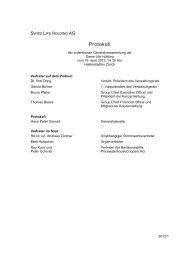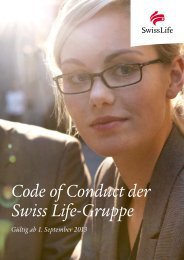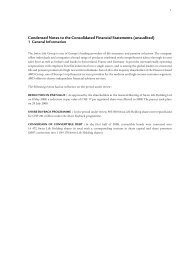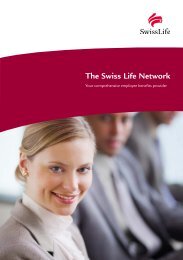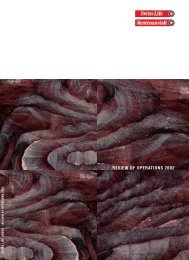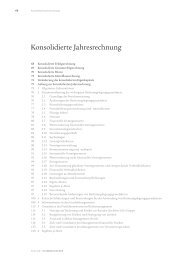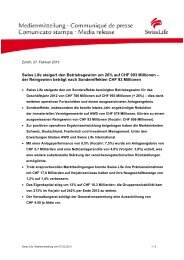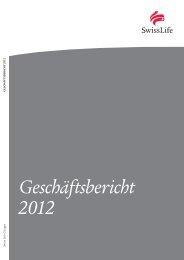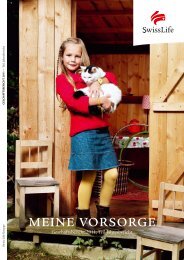Annual Report 2012 - Swiss Life
Annual Report 2012 - Swiss Life
Annual Report 2012 - Swiss Life
Create successful ePaper yourself
Turn your PDF publications into a flip-book with our unique Google optimized e-Paper software.
75 Market Consistent Embedded Value (MCEV)<br />
In CHF million Free surplus Required capital VIF MCEV MCEV<br />
<strong>2012</strong> 2011<br />
Opening MCEV 666 1 859 2 836 5 361 4 959<br />
Opening adjustments 56 – – 56 –98<br />
Adjusted opening MCEV 721 1 859 2 836 5 417 4 861<br />
Value of new business –272 172 257 158 150<br />
Expected existing business contribution (reference rate) 25 –15 19 30 14<br />
Expected existing business contribution (in excess of reference rate) 14 0 615 629 802<br />
Transfers from VIF and required capital to free surplus 686 –214 –473 – –<br />
Experience variances –319 116 209 5 –53<br />
Assumption changes –1 –5 455 449 79<br />
Other operating variance –69 –4 –206 –279 –282<br />
Operating MCEV earnings 66 50 876 992 710<br />
Economic variances 51 43 1 373 1 468 –507<br />
Other non-operating variances –10 3 –41 –47 102<br />
Total MCEV earnings 106 97 2 209 2 412 305<br />
Closing adjustments 46 7 6 59 195<br />
Closing MCEV 873 1 963 5 051 7 888 5 361<br />
OPENING ADJUSTMENTS<br />
Opening adjustments represent dividend payments from non-covered to covered business.<br />
VALUE OF NEW BUSINESS<br />
Value of new business contributions from free surplus and required capital sum up to the new business<br />
strain of CHF –99 million (2011: CHF –127 million). This represents the shareholders’ share in acquisition<br />
expenses for new business. The VIF-component of CHF 257 million (2011: CHF 277 million) is<br />
the value of future profits from new business.<br />
EXPECTED EXISTING BUSINESS CONTRIBUTION (REFERENCE RATE)<br />
Expected existing business contribution (reference rate) shows the unwinding of discount on all value<br />
of in-force components with reference rates as at start of year. Additionally the notional interest on<br />
the net asset value is included.<br />
EXPECTED EXISTING BUSINESS CONTRIBUTION (IN EXCESS OF REFERENCE RATE)<br />
Expected existing business contribution (in excess of reference rate) represents the additional contribution<br />
to MCEV by taking into account investment returns for the reporting period expected at the<br />
beginning of the period over and above the initial reference rates for the period. Also, releases from<br />
the period’s contribution to the time value of financial options and guarantees and cost of residual<br />
non-hedgeable risks are included. The expected business contribution is explained to a large extent by<br />
spreads expected to be earned on the corporate bond and real estate portfolio.<br />
TRANSFERS FROM VALUE IN FORCE AND REQUIRED CAPITAL TO FREE SURPLUS<br />
Transfers from value in force and required capital to free surplus include the transfer of the results of<br />
the preceding step from value in force to free surplus. Also, the required capital is normally reduced<br />
after this step, resulting in an equal increase of free surplus. The total effect in this line is zero. In the<br />
context of a life insurer’s business model, this should be seen in combination with effects from new<br />
business which partly reverses this effect by an increase of required capital and a reduction of net asset<br />
value.<br />
<strong>Swiss</strong> <strong>Life</strong> – <strong>Annual</strong> <strong>Report</strong> <strong>2012</strong>



